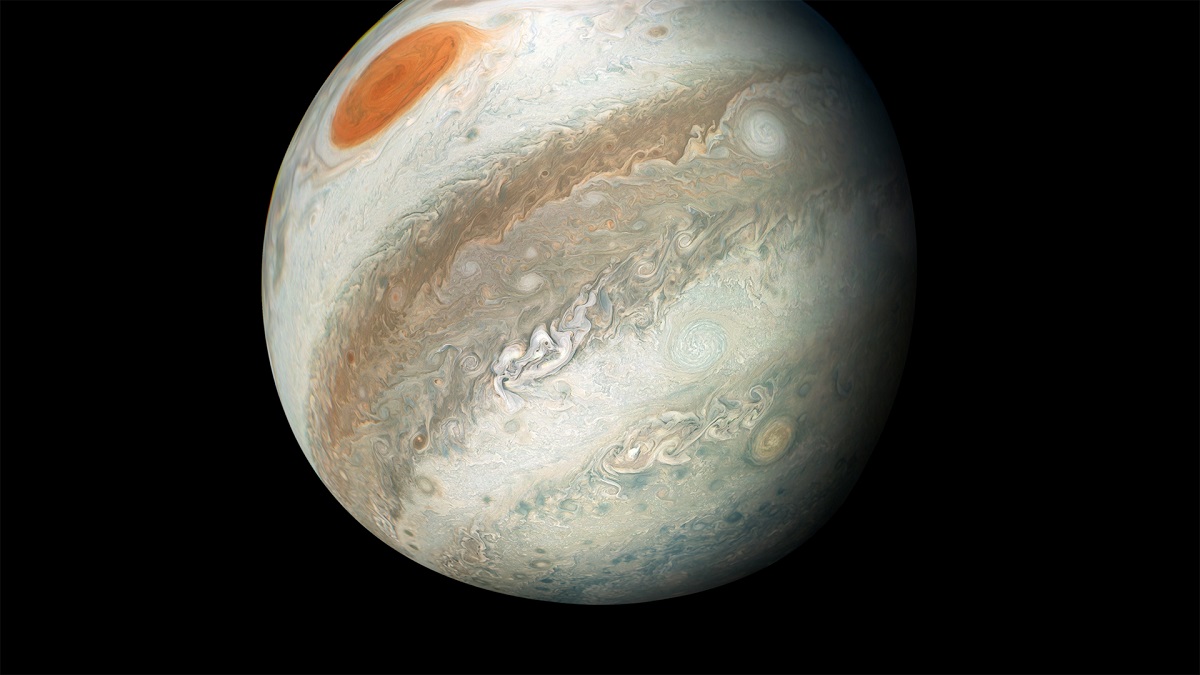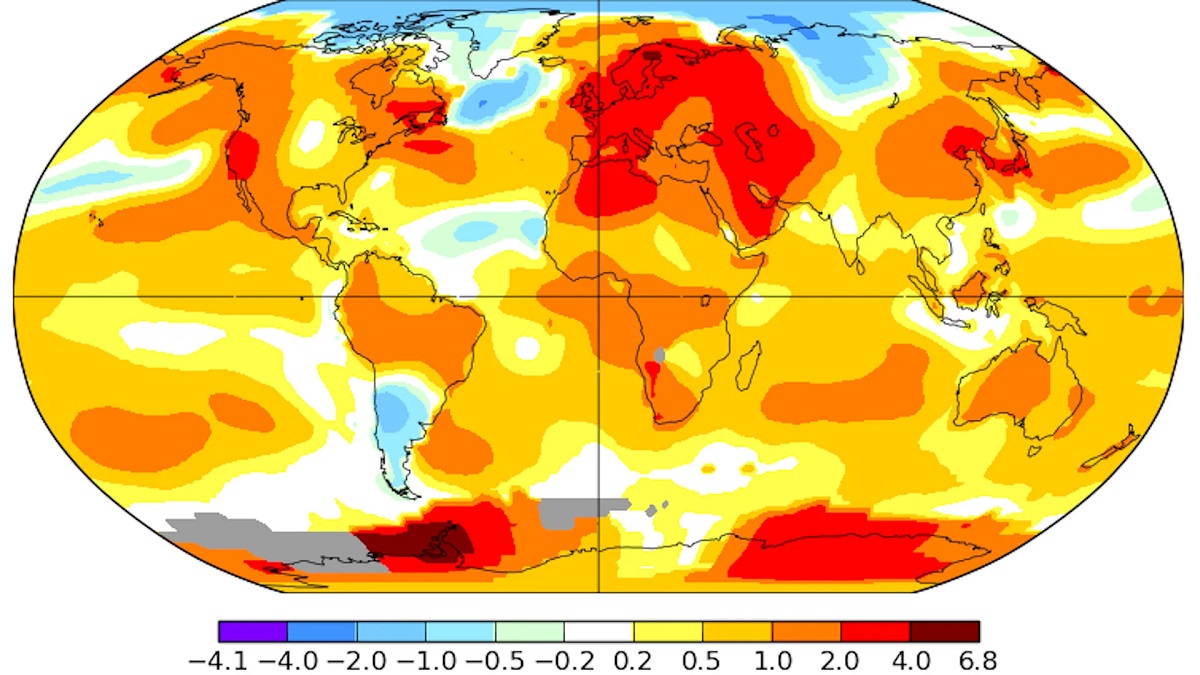Home>Weather and Climate>Exploring The Temperature Of Jupiter


Weather and Climate
Exploring The Temperature Of Jupiter
Published: March 2, 2024
Discover the intriguing weather and climate of Jupiter as we explore its temperature and atmospheric conditions. Uncover the mysteries of this gas giant's unique climate.
(Many of the links in this article redirect to a specific reviewed product. Your purchase of these products through affiliate links helps to generate commission for Temperatures.com, at no extra cost. Learn more)
Table of Contents
Introduction
Jupiter, the largest planet in our solar system, has long captivated the imagination of astronomers and space enthusiasts alike. Its immense size and striking appearance make it a prominent feature in our night sky. However, beyond its awe-inspiring presence, Jupiter holds many mysteries, including its temperature and weather patterns.
In this article, we will embark on a fascinating journey to explore the temperature of Jupiter, delving into its complex atmospheric conditions, core temperature, surface temperature, variability, and the profound impact of temperature on its weather. By unraveling these aspects, we can gain a deeper understanding of this gas giant and the forces that shape its dynamic environment.
Join us as we venture into the depths of Jupiter's atmosphere and uncover the secrets of its temperature, shedding light on the remarkable interplay between heat, pressure, and atmospheric dynamics that define this magnificent planet.
The Atmosphere of Jupiter
Jupiter's atmosphere is a mesmerizing tapestry of swirling clouds, powerful storms, and enigmatic features that have intrigued astronomers for centuries. Composed primarily of hydrogen and helium, with traces of other compounds such as ammonia, methane, and water vapor, Jupiter's atmosphere is a complex and dynamic system that defies easy categorization.
At the top of Jupiter's atmosphere, the visible cloud layers form intricate bands of varying colors, including shades of white, red, brown, and yellow. These bands are the result of complex interactions between different compounds and the planet's powerful winds, which can reach speeds of up to 384 miles per hour (618 kilometers per hour). The iconic Great Red Spot, a massive storm that has raged for centuries, serves as a testament to the turbulent nature of Jupiter's atmosphere.
Beneath the visible cloud layers, the atmosphere transitions into a dense layer of gas, where the pressure and temperature increase dramatically with depth. This transition leads to the formation of metallic hydrogen, a state of hydrogen that exhibits metallic properties due to the extreme pressure within Jupiter's core.
Furthermore, Jupiter's atmosphere is characterized by its extensive system of storms and vortices, including cyclones and anticyclones that can span thousands of kilometers. These atmospheric features contribute to the planet's dynamic and ever-changing weather patterns, shaping the temperature distribution and driving the complex interactions that define Jupiter's atmospheric dynamics.
The atmosphere of Jupiter is a realm of constant motion and energy, where the interplay of heat, pressure, and chemical processes gives rise to the breathtaking visual spectacle that we observe from afar. Understanding the intricacies of Jupiter's atmosphere is crucial to unraveling the mysteries of its temperature and weather patterns, providing valuable insights into the fundamental forces that govern this majestic gas giant.
As we continue our exploration of Jupiter's temperature, we will delve deeper into the core temperature, surface temperature, and the variability of this enigmatic planet, shedding light on the remarkable interplay between heat, pressure, and atmospheric dynamics that define its captivating nature.
The Core Temperature of Jupiter
At the heart of Jupiter lies a realm of extreme pressure and temperature, where the forces of gravity and compression converge to create a core unlike anything found on Earth. The core of Jupiter is a realm of intense heat and pressure, where the temperature soars to staggering levels under the immense weight of the planet's overlying atmosphere.
The core temperature of Jupiter is a subject of intense scientific interest, as it holds the key to understanding the planet's internal dynamics and the processes that govern its immense gravitational influence. While direct measurements of the core temperature are not feasible due to the planet's opaque atmosphere and extreme conditions, scientists have employed sophisticated models and theoretical calculations to estimate the temperature at Jupiter's core.
Based on these models, it is believed that the core temperature of Jupiter may reach tens of thousands of degrees Celsius, far exceeding the temperatures found at the surface of the Sun. This extreme heat is a result of the intense pressure generated by the overlying layers of gas, which compress the core to extraordinary densities and temperatures.
The core of Jupiter is thought to consist primarily of rock, metal, and a substantial amount of hydrogen and helium, compressed to such extremes that hydrogen transitions into a metallic state, exhibiting properties akin to those of a metal. This metallic hydrogen, formed under the intense pressures within the core, is believed to play a crucial role in generating Jupiter's powerful magnetic field, which extends far into space and interacts with the planet's surrounding environment.
The core temperature of Jupiter not only shapes the planet's internal structure and magnetic field but also influences its overall thermal balance and energy distribution. The immense heat emanating from the core contributes to the planet's overall thermal output, driving the complex atmospheric processes and weather patterns that define Jupiter's dynamic environment.
Understanding the core temperature of Jupiter is essential for unraveling the planet's enigmatic nature and gaining insights into the fundamental processes that govern its behavior. By probing the depths of Jupiter's core temperature, scientists can unlock the secrets of this colossal gas giant, shedding light on the intricate interplay between heat, pressure, and gravitational forces that define the innermost realms of our solar system's largest planet.
As we delve deeper into the temperature of Jupiter, we will explore the surface temperature, variability, and the profound impact of temperature on the planet's weather, unveiling the captivating dynamics that shape this celestial marvel.
The Surface Temperature of Jupiter
The surface temperature of Jupiter presents a fascinating enigma, as the planet lacks a solid surface akin to those found on terrestrial worlds. Instead, Jupiter's outer boundary is defined by the point at which its atmosphere transitions into a dense, opaque layer of gas. This region, known as the tropopause, marks the upper limit of the visible cloud layers and serves as the de facto "surface" of the planet.
At the tropopause, the temperature of Jupiter varies significantly depending on the altitude and location within the planet's dynamic atmosphere. Near the equator, where the atmosphere is subject to intense solar heating, the temperature at the tropopause can reach approximately 112 degrees Celsius (234 degrees Fahrenheit). In contrast, the polar regions experience cooler temperatures, with the tropopause hovering around -153 degrees Celsius (-243 degrees Fahrenheit).
These temperature variations are driven by Jupiter's complex atmospheric dynamics, including the planet's rapid rotation, powerful jet streams, and the redistribution of heat through atmospheric convection. The interplay of these factors results in a diverse thermal landscape, with distinct temperature profiles across different latitudes and longitudes.
Furthermore, as one descends into Jupiter's atmosphere, the temperature increases due to the compression of the overlying gases. At lower altitudes, the temperature can soar to hundreds of degrees Celsius, creating a hostile environment characterized by extreme heat and pressure.
It is important to note that the concept of a "surface temperature" on Jupiter differs from that of terrestrial planets, where a solid or liquid surface directly interacts with the atmosphere. Instead, Jupiter's surface temperature refers to the thermal conditions at the upper boundary of its atmosphere, offering a unique perspective on the planet's atmospheric dynamics and heat distribution.
Understanding the surface temperature of Jupiter is crucial for unraveling the planet's complex climate system and the interplay between solar radiation, atmospheric circulation, and thermal energy redistribution. By probing the intricate thermal patterns at Jupiter's "surface," scientists can gain valuable insights into the fundamental processes that govern the planet's atmospheric behavior and weather phenomena.
As we continue our exploration of Jupiter's temperature, we will delve into the variability of its thermal conditions and the profound impact of temperature on the planet's weather, unveiling the captivating dynamics that shape this celestial marvel.
The Variability of Jupiter's Temperature
The temperature of Jupiter exhibits remarkable variability across different regions of the planet, reflecting the complex interplay of atmospheric dynamics, solar radiation, and internal heat distribution. This variability is a defining characteristic of Jupiter's climate system, shaping the planet's weather patterns and contributing to its dynamic and ever-changing environment.
One of the key factors influencing the variability of Jupiter's temperature is its axial tilt, which is much smaller than that of Earth. This results in relatively mild seasonal temperature variations compared to our home planet. However, Jupiter's rapid rotation, completing a day in just under 10 hours, leads to significant temperature differences between its equatorial and polar regions. The intense solar heating near the equator drives higher temperatures in this region, while the polar areas experience cooler conditions due to reduced direct sunlight.
Furthermore, Jupiter's atmospheric circulation plays a crucial role in shaping temperature variability. The planet's powerful jet streams, including the prominent equatorial jet and polar vortices, contribute to the redistribution of heat across different latitudes, leading to distinct thermal profiles. These atmospheric dynamics create a patchwork of temperature patterns, with warm and cold regions coexisting in a delicate balance.
The presence of dynamic weather systems, including massive storms and vortices, also influences the variability of Jupiter's temperature. These atmospheric features can generate localized temperature anomalies, creating regions of intense heat or cooling within the planet's atmosphere. The iconic Great Red Spot, a colossal storm that has persisted for centuries, serves as a testament to the profound impact of dynamic weather phenomena on Jupiter's thermal landscape.
Moreover, Jupiter's internal heat sources, including residual heat from its formation and ongoing gravitational compression, contribute to the planet's overall thermal variability. The release of internal heat through the atmosphere, coupled with the influence of solar radiation, further amplifies the temperature contrasts observed across different regions of the planet.
Understanding the variability of Jupiter's temperature is essential for unraveling the intricate dynamics of its climate system and the interplay between atmospheric processes, solar influences, and internal heat sources. By probing the diverse thermal patterns that define Jupiter's atmosphere, scientists can gain valuable insights into the fundamental forces that govern the planet's weather phenomena and contribute to its captivating thermal tapestry.
As we continue our exploration of Jupiter's temperature, we will delve into the profound impact of temperature on the planet's weather, unveiling the captivating dynamics that shape this celestial marvel.
Read more: Exploring Colorado’s Winter Weather Patterns
The Impact of Temperature on Jupiter's Weather
The temperature of Jupiter exerts a profound influence on the planet's dynamic weather patterns, shaping its atmospheric dynamics and driving the formation of colossal storms, vortices, and cloud features. The interplay between temperature variations, atmospheric circulation, and heat distribution creates a mesmerizing tapestry of weather phenomena that define Jupiter's captivating climate system.
One of the key impacts of temperature on Jupiter's weather is the generation of powerful atmospheric disturbances, including the iconic Great Red Spot and other massive storms that dot the planet's cloud layers. These storms are fueled by the intense heat differentials within Jupiter's atmosphere, leading to the formation of convective cells and turbulent vortices that can persist for extended periods. The temperature gradients across different latitudes and altitudes contribute to the development and sustenance of these atmospheric features, showcasing the pivotal role of thermal dynamics in shaping Jupiter's weather.
Furthermore, the variability of Jupiter's temperature drives the planet's atmospheric circulation, giving rise to complex jet streams, equatorial bands, and polar vortices that govern the distribution of heat and energy across the planet. The interplay between temperature differentials and atmospheric dynamics leads to the formation of distinct cloud patterns and color bands, creating a visually stunning display of Jupiter's weather phenomena.
The impact of temperature on Jupiter's weather extends beyond the visible cloud layers, influencing the planet's internal energy balance and thermal structure. The intense heat emanating from Jupiter's core, coupled with solar radiation, drives atmospheric convection and heat redistribution, shaping the planet's overall climate system. These thermal processes contribute to the generation of localized weather patterns and the modulation of Jupiter's atmospheric properties, highlighting the intricate relationship between temperature and weather dynamics on this colossal gas giant.
Understanding the impact of temperature on Jupiter's weather is essential for unraveling the fundamental forces that govern the planet's atmospheric behavior and climate system. By probing the intricate interplay between thermal dynamics, atmospheric circulation, and weather phenomena, scientists can gain valuable insights into the captivating dynamics that shape Jupiter's celestial weather, offering a glimpse into the awe-inspiring forces at play within our solar system's largest planet.
Conclusion
In conclusion, the exploration of Jupiter's temperature unveils a captivating tapestry of thermal dynamics, atmospheric interactions, and weather phenomena that define the complex climate system of this colossal gas giant. From the swirling cloud bands at the top of its atmosphere to the intense heat and pressure within its core, Jupiter presents a mesmerizing interplay of temperature variations that shape its dynamic environment.
The atmosphere of Jupiter, characterized by its intricate cloud layers, powerful storms, and metallic hydrogen core, serves as a testament to the planet's remarkable thermal complexity. The variability of Jupiter's temperature, driven by factors such as axial tilt, atmospheric circulation, and internal heat sources, creates a diverse thermal landscape that influences the planet's weather patterns and atmospheric dynamics.
The profound impact of temperature on Jupiter's weather is evident in the formation of massive storms, convective processes, and atmospheric disturbances that define the planet's captivating climate system. The interplay between temperature differentials, atmospheric circulation, and heat distribution gives rise to the breathtaking visual spectacle of Jupiter's weather phenomena, showcasing the intricate relationship between thermal dynamics and atmospheric behavior.
By unraveling the secrets of Jupiter's temperature, scientists gain valuable insights into the fundamental forces that govern the planet's climate system, offering a glimpse into the awe-inspiring forces at play within our solar system's largest planet. The exploration of Jupiter's temperature not only deepens our understanding of this enigmatic gas giant but also sheds light on the broader mechanisms that govern planetary climates and atmospheric processes across the cosmos.
As we continue to peer into the depths of our celestial neighborhood, the exploration of Jupiter's temperature stands as a testament to the boundless wonders that await discovery within our solar system and beyond. The captivating interplay of heat, pressure, and atmospheric dynamics on Jupiter serves as a reminder of the profound forces that shape the celestial realms, inviting us to embark on a journey of exploration and discovery, unlocking the mysteries of our cosmic surroundings.
In the grand tapestry of the cosmos, Jupiter's temperature stands as a testament to the intricate dance of thermal forces that define the celestial wonders that grace our night sky, inspiring awe and wonder as we gaze upon the majestic gas giant and the captivating dynamics that shape its celestial weather.














